

In this case, let me present a graphical chart of the letters within the Latin Alphabet and interpret how I believe the letters represent important -- yet forgotten, visual concepts in nature that were once used as "science lessons" by teachers many generations ago. In Volume 2, Chapter 5 -- entitled "Mythical Pictographs" from my online Spirit of Atlantis project, I explain the idea that there exists images behind each letter of the Latin Alphabet -- and, if interpreted properly, suggests the view in which certain Latin "words" were originally used to "visualize" information as "sentences" -- which represent and communicate important abstract concepts in the early development of Western Civilization. In other words, letter symbols are little "pictures" that when placed together as a "word", tell a story -- and when further put together as a group of "words", tell a greater story as "sentences".
As an graphical artist that is always interested in pictorial concepts, let me teach some elementary views about how I believe certain Latin letters came into being.
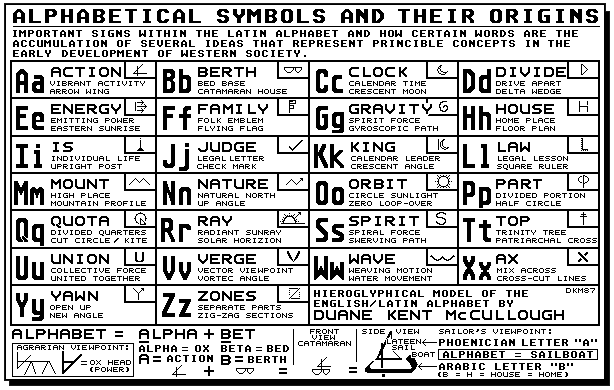
Many words are made up of letters that represent important "iconic ideas"
which took many generations to formulate..
Ogamic communication includes a twenty-count system of coded number values that is visually expressed by using vocal sounds with hand and finger gestures. This prehistoric method of communicating signals could also be used to visually send or read data as binary markings of dots and lines on wooden sticks or rocks -- and even smoke or light signals. Moreover, Ogamic coded signals could be used within drum beat sounds and was perhaps the most common means to send "wireless messages" over certain distances. Like some kind of forgotten Morse-code language system lost in time, early humans apparently once used this prehistoric alphabet to communicate messages over great distances.
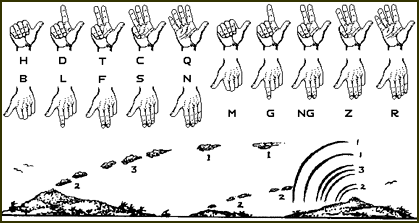
Ogamic Communication used by early humans.

Ogamic Communication used by maritime natives of the Atlantic.
In any event, after the disastrous Biblical Flood event, the ability to read and remember the coded signal rules within the language of Ogam was lost because the signals were too repetitious to understand and follow by the survivors of the Biblical Flood -- so, a new means of alphabetical communication was created that superceded the sound-based coded language of Ogam with an easier to remember method of understanding data. Based on graphical images that used phonetic vowel symbols that were "equally dispersed" throughout a collection of consonant symbols, this new alphabet -- known as the Latin Alphabet, became the new standard in communicating important information throughout Europe and adjacent areas.

Atlantis and Ogamic Communication used by early humans.
The creators of the Latin Alphabet were the sea-faring Phoenicians -- who not only developed the phonetic and graphical Latin Alphabet, but also brought about the Iron Age when they began using iron chains on their ships so that they could safely anchor offshore and better explore the coastlines of the world during their voyages. And, while the Latin Alphabet was becoming popular among merchants of trade, scripture versions of the graphical alphabet were also invented that used ink and scroll material to record and "write" information in parallel lines of graphical data -- or paragraphs, which were longer that "sentences" -- and much longer than "words".
And speaking of "words" while using the Latin Alphabet, in order for a graphical letter symbol statement or concept of visual expression to qualify as a "word", it must either be a vowel or if it is a consonant letter symbol, it must include an adjacent vowel symbol. In other words, a little known technical rule exist while using the Latin Alphabet in that all words must include at least one vowel symbol to qualify it as a proper unit of expression.
Moreover, as "paragraphic information" was becoming popular, early "literature" was written like how a farmer plows a field -- in that, instead of starting a new line of letters in sequence like we do today when we write and "run out of room" at the edge of a page or writing surface, early writers would just "plow" the next line of letters backwards in the opposite direction of the previous line -- thus, inorder to properly read early paragraphic literature, one had to be able to "read backwards" the sequence of letters to understand the true meaning of the messages within words.

How the ten-base counting of angle lines became
the numerical symbols of Western Civilization.
Regarding the Greco-Roman counting system of using letter symbols for number values, there exist a new concept in understanding the true counting values of the number system. Because the "M" symbol was not used in Biblical times to count true annual time, the symbol may have never been used as a proper unit in counting large numerical values -- particularly large numerical annual values -- therefore, the letter "M" may not have been part of the original Greco-Roman counting system. Although, according to some historians, Plato once recorded that Atlantis was destroyed some 9,000 years before the life of Solon, it now seems more likely that only a lunar count of 900 months -- or about 72 years, instead of 9,000 years, was the case.
Also, according to a new understanding of ancient history, because the Christian term "Thou - son" -- as in "Thy son of God", also equals the 1,000 or the "thousand" numerical value of "M", historians and scholars during the Renaissance Era falsely assumed and recorded the "M" symbol as having a numerical value of a "thousand" when counting or calculating annual time from the birth of Christ.
And one more interesting revelation regarding ancient history and the Greco-Roman number value system, all the number symbols -- with the exception of the letter "M" symbol, when added together in sequence -- as in "DCLXVI" or 500+100+50+10+5+1, equals the total value of 666. So, perhaps the mystery 666 number "of the beast" may be linked to this "revelation" in Biblical history -- in that western merchants living in Biblical times who used Roman numbers to count anything of value may have been preceived by certain ancient kingdoms living in what is now the "Middle East" that used a different counting system based on Cunieform, as "math wizards" from "the beastly Roman Empire" who used a "numerical language" of letters to invade the area.
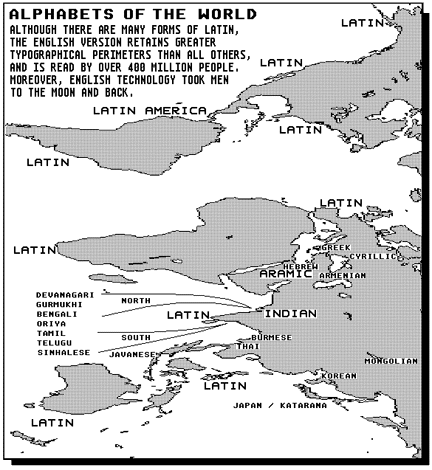
Alphabets of the world compared to the Latin Alphabet.
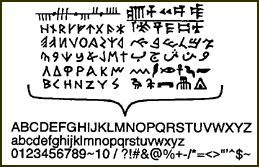
Alphabets of the world became the Latin Alphabet.
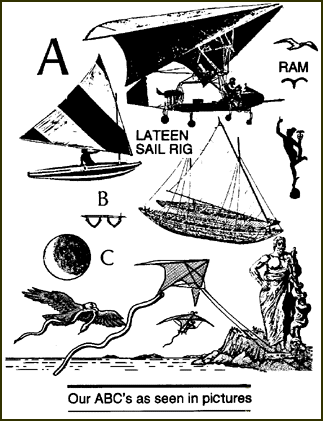
Our ABC's as seen in symbolic pictures that tell important stories.

The story within the letter "A".
The first letter of the Latin Alphabet also shares a story with the first sign of the Zodiac -- Aries, because the Aries symbol is identified with the "flaring horns" of some sort of "ram-like entity" that could "sail through the ariy skies" -- like a "winged angel". By the way, the constellation of Aries is right next to the last sign of the Zodiac -- which is the constellation of Taurus the Bull -- that does have an upside down "A" shape symbol found in the sign. Moreover, because the upside down Latin letter "A" symbol resembles the curved and flaring horns of a bull or ram-like animal -- and because one of the most unique treasure items in mythical history, known as the "Golden Fleece", was also based on a legendary story about how the "winged messenger" of the Gods -- named Hermes, who once piloted a "wondrous ram" to rescue some children near a seaside cliff, perhaps whosoever decided that the "A" symbol of a horned ram-like animal -- and some kind of legendary arrow-wing shaped "Angel kite" vehicle design with the power of human flight, were related somehow.

Did our ancient ancestors once fly ram-like hangliders?.



The letter "A" is based on the power shape of an arrow-wing design.
Perhaps the "Golden Fleece" story about a "wondrous ram" that was capable of human flight is related to this calf-like enitity covered in gold. Perhaps the flying horned ram kite vehicle concept looks similar to the idea of a small horned calf "model" -- with wings made with a fine fleece-like fabric -- woven from the golden fiber coat of a sheep. Perhaps a gold-like fleece fabric was used as a sail material and laced onto a double-lateen rigged aircraft design -- complete with a model head of ram and other decorated features that may have inspired viewers into believing the aircraft was a living animal. Was the "wondrous ram" -- piloted by Hermes, and the "golden calf" -- once worshipped as an idol in Biblical times, the same "A" shaped aircraft design?
For those who may think this story is a "load of bull" and that no such aircraft ever existed in Biblical times -- well, perhaps you need to review ancient history again and, this time, look for scientific clues that could prove what once seemed impossible -- was actually possible. So, let's say that there truely existed a ram-like kite aircraft that flew like a modern hanglider in Biblical times -- one would also have to ask how could such a glider travel great distances without some sort of simple light weight power motor or engine to keep it flying? The concept of a powered aircraft in Biblical times needs much more imagination to explain than just a simple hanglider story. However, because visual proof exist that our ancient ancestors in Biblical times once used powerful motors as cutting and drilling tools to shape large rock projects at prehistoric sites like in Egypt and Peru -- perhaps the idea that some sort of small steam tool or even electric motor device was once used to power a spinning prop and drive an winged aircraft aloft, is a plausible concept after all. Just look at the Caduceus wand device and what do you see -- a toy or a tool?
The letter "A" may also share some aspects of the same meaning within the letters of "C", "J", "L" and "V" because all use the same simple "wedge angle" symbol when "printed".

The story within the letter "B".
Conventional historians would have you believe that catamaran boats -- particularly catamaran sailboats, were never really used in ancient times. However, such is not the case. Native sailors throughout the Pacific and western Atlantic Oceans that used catamaran sailboats are now well known. In fact, multi-hull sailboats have many technological advantages over many single-hull sailboats. In any case, the capital Latin letter "B" represents "Berth" to a nautical sailor -- and to a landlubber, it represents the concept of a "Base" -- as in "Home Base", because the letter "H", like the letter "B", represents a sheltered place to rest. By the way, the capital Latin letter of "H" represents the floor plan of a House -- more about the story within the letter "H" later in this presentation.
Another interesting image similarity exist between the Ogamic letter "B" -- which looks like a flat line mark, and the word "flat" -- which also means a "Home Base" or a "place of rest" in English slang. Moreover, the capital letter "B" when viewed sideways also looks like the shape of a mother's "Breast" -- which if you were a baby, mother's Breast is a nice place to "bed-down" and rest.

The story within the letter "C".
So, if the capital Latin letter of "C" symbol represents a system of "counting calendar time" while using some kind of "Clock" instrument to measure the value of a solar day to that of the value of the "Crescent Moon" phases per solar year, then what kind of "C" shape "Clock" instrument could measure time long ago? Well, have you ever heard of a sun-dial? It measures solar time and has a large primitive angle "C" shape tool on top that cast a shadow on the "Clock" surface to mark the time of day. And if you are onboard a boat, you could measure time by marking the sun angle relative to the horizon using a sextant instrument shaped somewhat like the letter "C" and the letter "A".
It should also be pointed out that because the capital Latin letter of "C" is associated with the concept of "time" -- and because the power to control time over others long ago was in the hands of royal kings, perhaps the "ca" or "ka" sound -- as in "king" represents or personifies a "great leader" in historical time.
Speaking of time measurement, it is interesting to note that modern scientist use the letter of "C" to represent the speed of light value -- which, according to Albert Einstein, time stops if ever one should achieve the speed of light. Well, I'm sure nobody knew about the speed of light value back when they were creating the Latin Alphabet long ago -- at least I don't think so, but the concept of "time" and the origin of the Latin letter of "C" is still an interesting story.
The letter "C" may also share some aspects of the same meaning within the letters of "A", "J", "L" and "V" because all use the same simple "wedge angle" symbol when "printed".

The story within the letter "D".

The story within the letter "E".
Moreover, because the Hellenic sea-king god Poseidon -- who is identified holding a "Trident spear", was related to the founder of Babylon named Nimrod -- who was the grandson of Noah that built the "Tower of Babel", and is also associated with the Phoenician Sun God name of "Baal" -- who's home was a mysterious and prehistoric temple city site in what is now modern Lebanon named Baalbek, perhaps the word "Baal" is somehow also related to the "E-shape" energy symbol of the "Trident spear". And as a matter of fact, the Ogamic letters of "B" and "L" -- when grouped together almost equal three parallel lines -- which, according to some historians, is the mark of "Bel" that can be found in several places etched into stone along the coast of the New World.
By the way, although the mark of "Bel", can be found near the coast in New England, the West Indies and the Florida Keys, the Phoenician Sun God name of "Baal" may also be related to the former British country in the western Caribbean named "British Honduras" now known as "Belize" -- which is located next to Lake Izabal in Guatemala.
Now, some historians believe that Nimrod was non other than "Baal" himself and was not only the founder of Babylon, but was some kind of powerful sea king that challenged the "Sea Peoples" -- known as the Phoenicians, in ancient Phoenicia in Biblical times. In any case, what's important to remember is that "Baal" from Baalbek is also associated with some kind of powerful energy source once used to build the remarkable temple city site in Biblical times.
And regarding the three prong tipped "Trident spear" tool design again, according to certain legendary stories, the weapon may have been much more than just a "3-fork tool" used to stab fish with -- it may actually be related to some kind of directed "sonic energy tuning fork" weapon device when struck like a bell. How it once worked is not known at this time -- but let's explore a little more into the history of Baalbek and learn about a powerful source of energy that has been lost in time since the Biblical Flood event.
Remember earlier when it was mentioned in the Holy Bible that a religious "Bull-cult" tribe once worshipped the small bull-like idol -- or "Golden Calf" model? Well, many believe that the religious followers were actually the tribe of Dan -- and that their site of worship was at the mysterious Baalbek temple in Lebanon. Furthermore, Baalbek is where there exist at least three of the largest man-made blocks of stone in the world that were used to build part of a huge foundation platform long before the Roman Empire ever existed. These stone blocks weigh about 1,000 tons each -- and two more cut blocks at a nearby stone quarry weigh about 1,500 tons each. How these stones were cut and moved into place is a testament to some kind of mysterious and powerful energy technology that was once used long ago -- and the following theoretical views will try to explain part of the mystery.
Anyway, some new archeologist now believe that whoever built Baalbek -- also known as Helopolis, once used a lost technology, perhaps based on "sonic energy", that could cut through stone and even move or "leverage" large megalithic stonework into place. Helopolis was also the name of an Egyptian city of "On" -- near the Pyramids of Giza, where "Sun worshipping" was known to be practice by certain priest. Speaking of Helopolis, there are stories about ancient movable siege towers called "Helepolis" that were once used to "take-down cities" where, for example, at the nearby seaport of Tyre in Lebanon, a Helepolis tower was once built by the Roman military onboard a large catamaran barge to invade the city.
And also speaking of ancient man-made towers that could take down cities, some new historians now believe that the "Tower of Babel" -- built by the Assyrian King Nimrod, may have been located at the ancient site of Baalbek because the "Oracle of Baalbek" is where certain "information signals" were once "broadcast" to the public in prehistoric times. So, as the theory goes -- and this theory is a whopper, if the real "Tower of Babel" story was actually based on a forgotten design whereby a metal parabolic crucible lens -- shaped like a shallow "Bell", was placed upside down on the ground with the opening facing up and contained a mixture of "feldspathic rock and ilmenite sand" -- which included gyromagnetic and pizeoelectric material, that, when ignited by a certain "thermodynamic reaction ringing event", could create a huge rising plasma helical tower of electrified particles upward into the sky in the shape of an elongated torus beam so that it could be used as a "static field radio tower" to transmit "amplitude modulation signals" as "babbling propaganda" -- but exploded somehow and caused a great disaster, then Biblical history needs a major update in explaining how the Assyrian King Nimrod -- who rebelled against our Atlantean ancestors in ancient Phoenicia, was a real "bad guy" in Biblical times.
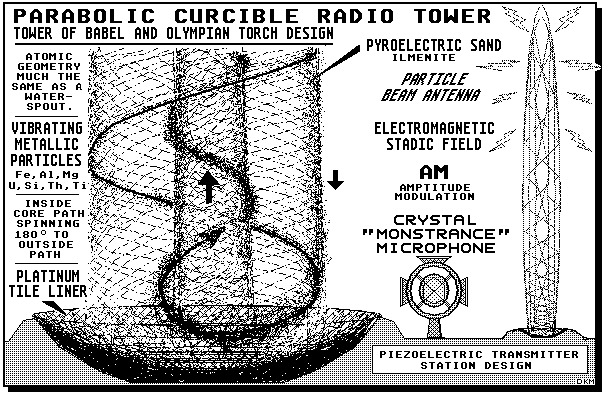
The parabolic crucible radio tower of Babel where "babbling signals"
were once transmitted.

The story within the letter "F".

The story within the letter "G".

The story within the letter "H".

The story within the letter "I".

The story within the letter "J".

The story within the letter "K".

The story within the letter "L".

The story within the letter "M".

The story within the letter "N".

The story within the letter "O".

The story within the letter "P".

The story within the letter "Q".

The story within the letter "R".

The story within the letter "S".

The story within the letter "T".
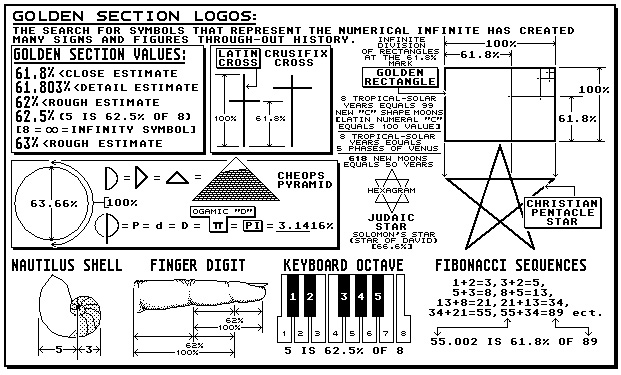
Golden Section measurement logos.
The second cross symbol that looks like the "T" image is the "Crucifix Cross" that has a higher cross-arm ratio mark than the "Latin Cross" and represents the ultimate Christian sacrifice -- whereby the "government execution" of Jesus Christ on a high cross pole became an everlasting reminder of how "the good" can be destroyed by "human ignorance".
The third cross symbol is the "Patriarchal Cross" -- which may represent a combination of both the "Latin and Crucifix Crosses", in that both crossing line marks are on the same main line. The slanted lower cross mark looks like the Ogamic letter of "M" and may represent a "high place" where "God lives".
The Latin letter of "T" also shares meaning with the letter of "X" because the death of Jesus Christ and the concept of death -- or "crossing out" something have similar values.

The story within the letter "U".

The story within the letter "V".

The story within the letter "W".

The story within the letter "X".

The story within the letter "Y".

The story within the letter "Z".
So, now that we have a better understanding about how some of the images within the Latin letter symbols have "hidden meanings", let's quickly explore how a set of "letter images" can also have meaning and tell a "picture story" as a "word" if interpreted properly. However, before we continue, it is important to understand that the abstract art of "deciphering" or "interpreting" the meanings within a set of "letter images" have certain limitations because too much imagination and "wild speculation" of seeing things that may not be true, can result in a false translation of meaning -- therefore, care should be used before concluding the true meaning within a set of "letter images". Also, because the odds favor that there exist more than one meaning per set of "letter images", one should not focus too much on just one meaning.
By studying the following image graphic, perhaps we can see or "read" stories within certain sets of Latin letters.
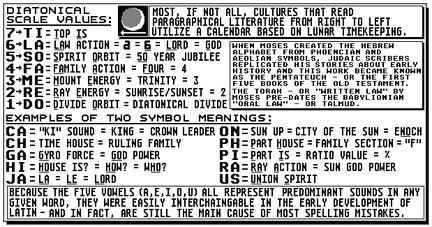
Two-letter symbol sets and their meanings in the Latin Alphabet.
"CA" = "Clock Action" = "Ka" or "Ki" sound = "King" = "Crown leader and time keeper".
"CH" = "Clock House" = "time house" = "ruling family".
"GA" = "Gravity Action" = "Gyro Action" = "Gyroscopic Force" = "God Power".
"HI" = "House Is?" = "How?" = "Greeting word by North American natives" = "Who?".
"JA" = "Judge Action" = "Law Action" = "LA" = "LE" = "The" = "Lord".
"ON" = "Orbit Nature" = "Circle up" = "Sun up North end" = "Energy On" = "City of the Sun" = "Enoch walked with God and built a city".
"PH" = "Part House" = "Family section Place" = "F" sound.
"PI" = "Part Is" = "Ratio proportion value" = "%".
"RA" = "Ray Action" = "Sun Activity" = "Sun God" = "Egyptian King of RA".
"US" = "Union Spirit" = "Our collective spirit".
More examples of meaning within certain sets of Latin letters are as follows:
"The" = "Top House Energy" = "God" -- as in "theology" or the study of "God".
"Love" = "Law Orbit Verge Energy" = "The eternal coming together" -- as in "Law of Attracting Orbital Energy".
"Trust" = "Top Ray Union Spirit The" = "The Highest Spiral Ray of United Energy" -- as in "Reliance".
"Hope" = "House Orbit Part Energy" = "Home Place of Energy" -- as in "Desired Place".
"Latin" = "Law Action Top Is Nature" = "La + Ten" = "The Ten" = "The Ten Kings of Atlantis".
The previous examples of some "letter image" meanings are only meant to show how some words can be deciphered. Many modern words do not always make sense using these examples because whoever created them may not have known about the images within the letters that make up the words -- and centuries of "slang talk" using said letter sets has also corrupted their original meanings.
Anyway, let's take the next step in this quest to understand the graphical stories within words and sentences -- which is the art of deciphering groups of letter set images. For example, names of places -- like "Europe", "Africa", "Asia" and other places.
"Europe" = "Energy/Emitting United Ray Orbit Part" or "the ra part" = "the radiant place" -- as in "the place where energy/people spread out from" or "colonize out from".
'Africa" = "Action Family Ray Is Clock" = "Active Family Sun-Ray King" or "Sun King Family" -- as in "place of Egyptian Sun God Father RA the Time Keeper".
"Asia" = "Action Spirit Is" = "Spirit Action Lives" -- as in the place where the human spirit lives.
"England" = "Energy Up Gravity + Law Action Nature Divide" = "Gravity Energy + Land" = "The Natural Spirit Force of North East Land of the Atlantic".
"India" = "Is Nature Divide Is Action" = "Action is life part" = "Place of living action".
"Jamaica" = "Judge Action + Mount Action Is Clock Action" = "JA + MA + I + CA" = "La + Mother + Is + King" = "The mother is Queen" = "Queen Mother".
"Japan" = "Judge Action Part Action Nature" = "JA + PA + N" = "La/Le + Pa + N" = "The + father + end stop" = "The Father" or "The Father North".
"Ocean" = "Orbit Clock Energy Action Nature" = "Circle King Nature" = "Natural Circle King" = "The Natural Sun Circle King and surrounding Ocean God".
"Pacific" = "Part Action Clock Is Family Is Clock" = "Pa + CI + F + IC" = "father + Clock + Family + Is King" = "Sea King Father of Family".
"Atlantis" = "Action Top Law Arrow Nature Top Is Spirit" = "Action Top + LAN + Top + I + S" = "Highest Land highest In Spirit".
"Yucatan" = "Yawn/open/new Union Clock/king Action Top Action Nature" = "New + U + CA + TAN" = "New United King Ten" = "The Ten United Kings" = "Home of British Honduras and once part of the United Kingdom".
I could ramble on about the graphical evolution of the Latin Alphabet -- and it's early relationship to the Ogamic Aphabet, but at some point -- like now, I need to stop and take some questions regarding my theories and this Interview.
Reporter 1: Very Interesting presentation -- the idea that there exist hidden codes based on graphic images within the letters of the Latin Alphabet is unique. When and where did you become aware of this theoritcal concept regarding the idea that the first alphabet used by humans was based on the numerical counting codes of Ogam -- and how these codes evolved over time into the graphical Latin Alphabet?
Duane: Well, back in 1988 when I lived on my sailboat in the Florida Keys and had plenty of time to research educational information at nearby libraries, I self published my Spirit Of Atlantis Book project -- which made me aware of the theory that the letters of Latin Alphabet are "little pictures" or "logos of meaning". As an artist who once painted outdoor signs and former Art Director -- with years of experience working with lots of typographical information, I have have studied the many stories within simple image signs and symbols --so, it was natural for me to make assumptions and theories regarding the imagery within letters.
Back in the early eighties -- way before the Internet, I came upon information in a local library about the ancient Ogamic Alphabet in Ireland and the Mayan number count system -- both of which used a twenty-count dot and bar or line markings to record coded data. Over time, I began to describe my adventure of discovery into the subject of Atlantis -- where the first two volumes of my book project is a record of my theories regarding the numerical and graphical evolution of the Latin Alphabet.
The crude black & white artwork displayed in this presentation and other Interviews was done on my Atari computer back in the eighties -- and although some newer artwork can be found at my spiritofatlantis.com website, I have kept the "retro-look" of the older Atari artwork because it seems like it "comes from the past" -- like the real story of Atlantis does.
Reporter 2: Your theoretical stories about the origins of the Latin Alphabet and Atlantis are interesting to say the least. It's a shame that the Main-stream Media has not contact you about your research into the subject of Atlantis. I know you have said that you have tried contacting some news services years ago -- but have you considered trying again?
Duane: As you can imagine, after some thirty years of "telling my stories" in print and online without any apparent success in getting the idea that the seaport city of Atlantis was real place and can be found in Central America on the bottom of Lake Izabal -- I almost don't care anymore if the public becomes aware of what I've tried to prove regarding Atlantis.
Actually, I do care if the public becomes aware of my research work -- it's just that I'm tired of repeating myself over and over without any significant results. I guess when the time is ripe for the subject of Atlantis to really make the news, then perhaps -- and only then, I may "hustle my theories" again to the MSM.
Currently, I am so disappointed in the MSM and their socialistic political values in pushing "fake news" and "useless news", with "Trump bashing" stories, I have no desire to contact anybody related to them. Besides, I value my privacy and would not want to have it interrupted by amateur reporters asking questions that I have already answered years ago at my SOA website. So, as it stands, all I care to do is what I'm doing now -- quietly publishing on the Internet all that I know about Atlantis and the lost technology associated with it.
Reporter 3: Details aside, your radical timeline argument about when Atlantis existed in historical time will be your greatest challenge in getting the public to listen to you. Do you have any new angle in convincing first time visitors to your SOA website that all the annual dates of conventional history beyond five centuries ago they have been taught their entire lives are wrong? And wrong in a very big way?
Duane: Like I just said -- I almost don't care anymore if the public becomes aware of what I've tried to prove regarding Atlantis. And no, I do not have any "new angle" in my attempt to show or explain to the public about my radical timeline about when Atlantis existed. Apart from a new video I did on YouTube a couple of months ago regarding my new timeline of history, no new attempt to "advertise" my historical timeline to the public is planned.
Apparently, the day when the seaport city of Atlantis gets discovered in Central America by some kind of big news event, will be the day that modern historians will have to begin questioning every important annual date within conventional history beyond five centuries ago and start writing a new history of Western Civilization based on our maritime Atlantean heritage. Only then will my theories become clear enough to understand and perhaps be used as a template of true human history.
END 50th INTERVIEW 5/18
ATLANTEAN COMMUNICATIONS Page
Return to the Homepage site